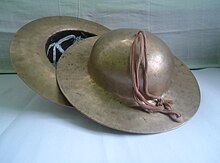Manjira
It has been suggested that this article be merged into Taal (instrument). (Discuss) Proposed since November 2013. |
This article needs additional citations for verification. (December 2009) |

Manjira (also spelled manjīrā or manjeera) is a traditional percussion instrument from India. In its simplest form, it consists of a pair of small hand cymbals.[1] It is also known as taal, jalra, khartàl or gini.
Manjiras are commonly played in folk and devotional music. They are played in various religious events and ceremonies in India and especially in bhajans. Manjiras are ancient musical instruments. Manjiras can be seen in many ancient temple pictures.
Manjiras are usually made of bronze, brass, copper, or zinc. The two cymbals may be connected by a cord passing through the holes in their centers or may not be connected at all. They produce a high-pitched percussive sound when struck together. The sound's pitch varies according to their size, weight and the material of their construction. A player can also adjust the timbre by varying the point of contact while playing.

The name manjira or khartal can also refer to a similar instrument made of a wooden frame with rows of cymbals inside.
Gujarati folk music
Manjiras have a significant importance in Gujarati and Marathi folk music. In Maharashtra they are known as Taal (टाळ). Initially Manjiras were played in aarti. In Gujarat and Maharashtra, manjiras hold great importance and are played in bhajan, santvani and dayro.
See also
Notes
- ^ Caudhurī, Vimalakānta Rôya (2007). The Dictionary Of Hindustani Classical Music. Delhi, India: Motilal Banarsidass. p. 173. ISBN 978-81-208-1708-1., originally published in 2000
